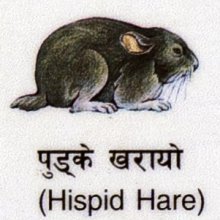Hare: 7 definitions
Introduction:
Hare means something in Buddhism, Pali, Jainism, Prakrit, Hindi, biology. If you want to know the exact meaning, history, etymology or English translation of this term then check out the descriptions on this page. Add your comment or reference to a book if you want to contribute to this summary article.
Images (photo gallery)
In Buddhism
Tibetan Buddhism (Vajrayana or tantric Buddhism)
Source: academia.edu: The Structure and Meanings of the Heruka MaṇḍalaThe Hare (animal) is associated with the Yoginī (female deity) named Śaśī, being situated in the Medinīcakra, according to the 10th century Ḍākārṇava-tantra: one of the last Tibetan Tantric scriptures belonging to the Buddhist Saṃvara tradition consisting of 51 chapters.—Accordingly, the medinīcakra refers to one of the three divisions of the dharma-puṭa (‘dharma layer’), situated in the Herukamaṇḍala. The 36 pairs of Ḍākinīs [viz., Śaśī] and Vīras are yellow in color; the shapes of their faces are in accordance with their names [e.g., Hare]; they have four arms; they hold a skull bowl, a skull staff, a small drum, and a knife.

Tibetan Buddhism includes schools such as Nyingma, Kadampa, Kagyu and Gelug. Their primary canon of literature is divided in two broad categories: The Kangyur, which consists of Buddha’s words, and the Tengyur, which includes commentaries from various sources. Esotericism and tantra techniques (vajrayāna) are collected indepently.
Biology (plants and animals)
Source: Wisdom Library: Local Names of Plants and DrugsHale [हले] in the Nepali language is the name of a plant identified with Rumex acetosa L. from the Polygonaceae (Knotweed) family having the following synonyms: Acetosa hastifolia, Acetosa amplexicaulis, Acetosa officinalis. For the possible medicinal usage of hale, you can check this page for potential sources and references, although be aware that any some or none of the side-effects may not be mentioned here, wether they be harmful or beneficial to health.
Hale in the Kannada language is the name of a plant identified with Glebionis coronaria (L.) Cass. ex Spach from the Asteraceae (Sunflower) family having the following synonyms: Chrysanthemum coronarium, Chrysanthemum speciosum.
Hale [ಹಾಲೆ] in the Kannada language is the name of a plant identified with Wrightia tinctoria (Roxb.) R.Br. from the Apocynaceae (oleander) family.
Source: Google Books: CRC World Dictionary (Regional names)1) Hale in India is the name of a plant defined with Alstonia scholaris in various botanical sources. This page contains potential references in Ayurveda, modern medicine, and other folk traditions or local practices It has the synonym Beluttakaka malabarica Kuntze (among others).
2) Hale is also identified with Chrysanthellum integrifolium It has the synonym Chrysanthemum coronarium L. (etc.).
3) Hale is also identified with Chrysophyllum roxburghii It has the synonym Donella lanceolatum var. stellatocarpon (P. Royen) X.Y. Chang (etc.).
4) Hale is also identified with Holarrhena pubescens It has the synonym Echites antidysentericus Roth, nom. illeg., non Echites antidysentericus (L.) Roxb. ex Fleming (etc.).
5) Hale is also identified with Wrightia tinctoria.
Example references for further research on medicinal uses or toxicity (see latin names for full list):
· On the Asclepiadeae (1810)
· Journal of Ethnopharmacology (1999)
· Flore du Cambodge du Laos et du Vietnam (1963)
· The Civil and Natural History of Jamaica (1756)
· Phytochemistry.
· Pharmacology. (2005)
If you are looking for specific details regarding Hale, for example side effects, chemical composition, extract dosage, diet and recipes, pregnancy safety, health benefits, have a look at these references.

This sections includes definitions from the five kingdoms of living things: Animals, Plants, Fungi, Protists and Monera. It will include both the official binomial nomenclature (scientific names usually in Latin) as well as regional spellings and variants.
Languages of India and abroad
Pali-English dictionary
Source: BuddhaSasana: Concise Pali-English Dictionaryhare : a particle used in addressing inferiors.

Pali is the language of the Tipiṭaka, which is the sacred canon of Theravāda Buddhism and contains much of the Buddha’s speech. Closeley related to Sanskrit, both languages are used interchangeably between religions.
Hindi dictionary
Source: DDSA: A practical Hindi-English dictionaryHare (हरे):—(int) O God !; —[kṛṣṇa] O Krishna, ! O God !; —[rāma] O Ram, O God !
...
Prakrit-English dictionary
Source: DDSA: Paia-sadda-mahannavo; a comprehensive Prakrit Hindi dictionaryHare (हरे) in the Prakrit language is related to the Sanskrit word: Are.
Prakrit is an ancient language closely associated with both Pali and Sanskrit. Jain literature is often composed in this language or sub-dialects, such as the Agamas and their commentaries which are written in Ardhamagadhi and Maharashtri Prakrit. The earliest extant texts can be dated to as early as the 4th century BCE although core portions might be older.
Kannada-English dictionary
Source: Alar: Kannada-English corpusHare (ಹರೆ):—
1) [verb] to be stretched or opened out over a flat surface; to be spread out.
2) [verb] to spread (oneself) like a creeper over a wider area.
3) [verb] (an assembly, persons assembled) to break up and move away.
4) [verb] to go away.
5) [verb] to be destroyed or spoiled completely.
6) [verb] to become disarranged and untidy; to become dishevelled.
7) [verb] to mix up with something and become dirty or soiled.
8) [verb] to be scattered or strewn around in a disorderly manner.
9) [verb] to become expanded, spread out.
10) [verb] to move forward.
11) [verb] to join, associate (oneself) with.
12) [verb] to begin to be day; to dawn.
13) [verb] to move forward by dragging the body along the ground, as aworm; to crawl.
--- OR ---
Hare (ಹರೆ):—[noun] the time in the morning when daylight first appears; dawn.
--- OR ---
Hare (ಹರೆ):—[noun] a percussion instrument consisting of a hollow hemisphere with a wide mouth on which a membrane stretched tightly, played by beating with the sticks; a kind of drum.
--- OR ---
Hare (ಹರೆ):—
1) [noun] that which covers, veils something; a cover; a veil.
2) [noun] a fold of a cloth, paper, etc.
3) [noun] the thin, outer layer of the skin of a snake that is periodically cast off.
4) [noun] the opaqueness of the crystalline lense or its capsule, as caused by cataract, resulting in partial or total blindness.
5) [noun] the innermost coat of the posterior part of the eyeball that receives the image produced by the lens, is continuous with the optic nerve, and consists of several layers, one of which contains the rods and cones that are sensitive to light; the retina.
6) [noun] a thin membrane that separates the middle ear from the external ear and vibrates when struck by sound waves; the eardrum; tympanic membrane.
7) [noun] a fault; a flaw.
8) [noun] hypocritical cunning or deception; double-dealing; duplicity; dishonest dealing.
9) [noun] a resinous substance secreted by a species of insect, Laccifer lacca, that live on certain fig, soapberry, and acacia trees; lac.
10) [noun] an unreal, deceptive or misleading appearance or image.
11) [noun] the thin cover that envelops the faetus during its gestation period and which is discharged shortly after birth; placenta.
12) [noun] little scales or flakes of dead skin formed on the scalp; dandruff.
13) [noun] the outside covering of the stems and roots of trees and woody plants; the bark.
14) [noun] the amount or quantity by which one thing differes from another; difference.
15) [noun] 'the tube, in the respiratory tract of most land vertebrates, extending from the larynx to the two bronchi; the windpipe: trachea.'
--- OR ---
Hare (ಹರೆ):—
1) [noun] any woody extension growing from the trunk or main stem or from a main limb, of a tree; a branch.
2) [noun] (dial.) a new growth in a plant at its node.
--- OR ---
Hare (ಹರೆ):—[noun] = ಹರೆಯ [hareya].
--- OR ---
Haṟe (ಹಱೆ):—[noun] a percussion instrument consisting of a hollow hemisphere with a wide mouth on which a membrane stretched tightly, played by beating with the sticks; a kind of drum.
--- OR ---
Hāre (ಹಾರೆ):—
1) [noun] a long metal bar, usu. with a bent, wedge-shaped end, used for digging and also as a lever for prying; a crow-bar.
2) [noun] a short, thick, wedge shaped iron piece, used to pound or pulverise in kitchen.
Kannada is a Dravidian language (as opposed to the Indo-European language family) mainly spoken in the southwestern region of India.
See also (Relevant definitions)
Starts with (+29): Hare-jhaar, Hare-jhar, Harebell, Haredachhaga, Hareek, Hareetaki, Haregadi, Haregadisu, Haregale, Haregara, Haregattige, Hareguttu, Harehamdal, Harein, Harek, Hareka, Hareka-vastu, Harekara, Harekolu, Harekrishnamahamantrarthanirupana.
Ends with (+125): Adachare, Ahahare, Aidudhare, Ainahare, Alagudhare, Amritadhare, Arachare, Arunadhare, Ashare, Asidhare, Asilatadhare, Asrigdhare, Balagadhare, Baydhare, Bayidhare, Bhare, Bhavahare, Bhurebhare, Bimbadhare, Birhare.
Full-text (+265): Shasha, Sasaka, Romakarnaka, Lambakarna, Vanakhu, Shulika, Sasavisana, Shashadhara, Shashamatra, Lomakarna, Shashorna, Harinama, Shashayu, Bileshaya, Sasin, Shilimukha, Hotatutya, Shashaloman, Pelaka, Ravakhandem.
Relevant text
Search found 176 books and stories containing Hare, Hāre, Haṟe, Harē; (plurals include: Hares, Hāres, Haṟes, Harēs). You can also click to the full overview containing English textual excerpts. Below are direct links for the most relevant articles:
Folklore of the Santal Parganas
Chapter CLXVII - Hares and Men < [Part V]
Chapter CXXI - The Jackal and the Hare < [Part II]
Chapter LXXX - Seven-Tricks and Single-Trick < [Part I]
Village Folk-tales of Ceylon (Sri Lanka), vol. 1-3 (by Henry Parker)
Story 41 - The Kadambawa Men And The Hares < [Part II (b) - Stories of the Tom-tom Beaters]
Story 30 - The Jackal And The Hare < [Part I - Stories told by the Cultivating Caste and Vaeddas]
Story 66 - The Cat Who Guarded The Precepts < [Part II (c) - Stories of the Durayas]
Hitopadesha (English translation) (by Sir Edwin Arnold)
Chapter 3 - The Story of the Old Hare and the Elephants < [Book Three - War]
Chapter 8 - The Story of the Lion and the Old Hare < [Book Two - The Parting of Friends]
Chapter 7 - The Story of the Black Snake and the Golden Chain < [Book Two - The Parting of Friends]
The Jataka tales [English], Volume 1-6 (by Robert Chalmers)
Jataka 322: Daddabha-jātaka < [Volume 3]
Jataka 454: Ghata-jātaka < [Volume 4]
Jataka 316: Sasa-jātaka < [Volume 3]
A Collection of Popular Tales from the Norse and North German (by Peter Christian Asbjørsen)
Brahma Sutras (Shankaracharya) (by George Thibaut)
Related products



